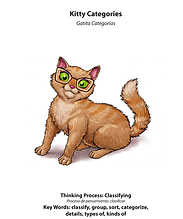

RESOURCES
The Thinking Friends program consists of a set of two books: the Thinking Friends Teacher's and Parent's Guide and a Thinking Friends Stories booklet. Included in the Guide is an easy to use mini-poster set enclosed ... and limitless creative application ideas!
Thinking Friends© Teacher's
and Parent's Guide
The Thinking Friends© Teacher’s and Parent’s Guide for Developing Thinking in Children is your primary source for learning how to effectively introduce young learners to Thinking Friends© and integrate Thinking Friends© into all aspects of daily learning activities and experiences.

What will I find in the Thinking Friends® Guide?
The Thinking Friends® guide provides you with a complete design for systematically implementing the program in an early childhood center or primary years grades pre-k thru second grade. You can view the table of contents here. Each of the Friends has a complete 5-Step implementation sequence that is highly adaptable for the age range at your center, school or at home (Snakey loves that Sequence!). This carefully scaffolded 5-Step Plan and resources for each of the Thinking Friends support you in introducing them to children in a meaningful developmentally appropriate manner using the mini poster set that is included in the Guide. Here is an example of the 5-Step plan for introducing Cowsie Cows n' Effect.
Within the Thinking Friends Guide is included a mini poster set (9 posters) that are used during the 5-Step Plan for each Friend and for follow up activities. The posters in the guide are often displayed while the stories are read to young learners from the Thinking Friends Stories book. See the posters below and description of the larger, laminated Thinking Friends Poster Set that you may order separately.
Background on each of the Thinking Friends©, their individual cognitive styles and approaches to learning is provided. Suggestions are offered for how to effectively interact with children through the Thinking Friends© stories, before, during and after reading each story.
Thinking Friends© Stories Booklet
Included in the separate Story book are eleven chapters: there are eight stories (available in Spanish and English) that introduce each of the individual animal characters as they interact with Farmer Framer. These introductory pieces are followed by three stories in which the characters and Farmer Framer interact as a group. You can view the table of contents here.
Click on this sample story: Snakey Sequencer Meets Farmer Framer
includes an introduction with outcomes, assessment and pre-reading; followed by the story; and concluding with Post-Reading activities.

Thinking Friends© Poster Set
NOW AVAILABLE ! Nine 11" x 17" Laminated Poster Set
A separate, laminated Thinking Friends Poster Set is now available. This set of nine 11" x 17" posters enables even more flexible use and continuous visual reference points for all your Thinking Friends. Young learners can have Thinking Friends posted in their rooms at home and/or visible in classrooms for helping them at any time as they think through problems!









What happens after children have been
introduced to all the Thinking Friends©?
Because we do not typically use only one thinking strategy to solve problems as we go through our day, the final three stories in the Guide show the Thinking Friends® working together with Farmer Framer. In these stories, the “thinking friends” think and problem-solve interdependently and begin to develop the thinking skills that each other represents. The Farmer “frames” the questions for the friends who work together using their thinking styles to contribute solutions. Farmer Framer helps all the Thinking Friends® to identify patterns and to think about their thinking. In the process they learn essential social-emotional Habits of Mind in order to think flexibly, work interdependently, and persist in solving complex challenges with a solution they all had a hand or hoof in designing. These final 3 stories become key reference points for you to use as you guide children in learning the same lessons through the experiences you continue to provide at home and in the classroom.
Thinking Friends© for Formative Assessment How do I know whether or not children are benefiting from Thinking Friends©?
.jpg)
It is possible as teachers and parents to use the Thinking Friends© to help assess a child’s cognitive strengths and areas of difficulty. Knowing what to look and listen for will be important as you seek to determine the impact Thinking Friends© is having on your children. The Guide offers specific benchmarks that will help focus your observations. In addition, there are a series of tasks that children can complete with an adult once they fully understand the cognitive strengths of each character. That is, a child can identify and purposefully engage in sequencing, causal reasoning, spatial reasoning, using analogies, describing, defining in context, comparing, contrasting, and classifying. As the teacher, parent or adult caregiver, you can create other activities that are relevant within the child’s life at home or at school. The tasks can be made more complex as children mature.